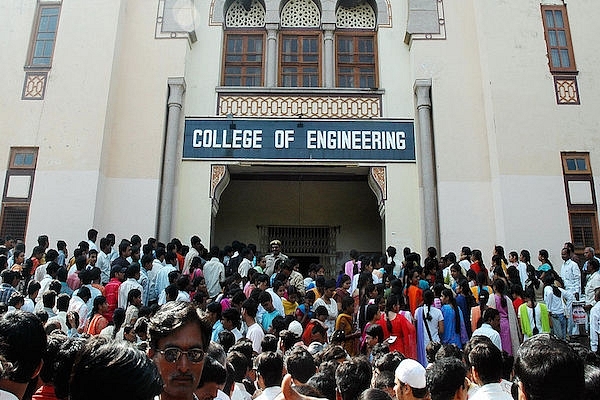Ideas
Why Grade Inflation Should Be Discouraged, Not Applauded
- Grade Inflation is a phenomenon wherein the organisation, i.e., the examination board increases the grades of their students to make them look good on paperIn the long run, grade inflation will debase the value of grades and have an important effect on the ways students are judged by educational institutions

India College (NOAH SEELAM/AFP/Getty Images)
Over the past few weeks, we have been witnessing the release of exam results and newspapers making a hullabaloo of it, writing reams of stories on the lives of the top scorers.
All this time, a certain phrase was used, in passing, to describe a phenomenon whose impact on the quality and cost of our education system has been considerable. That phrase was “grade inflation”.
Grade Inflation is a phenomenon wherein the organisation, i.e., the examination board jacks up the grades of their students to make them look good. The board looks good as more parents opt to enrol their children under these boards, to ensure better grades. The student looks good on paper, and this helps in the admission process for colleges. Their parents can also boast about it. Everything is so hunky-dory.
This phenomenon is a problem that isn’t immediately apparent to most involved in the process. What most of us don’t realise is that grade inflation manages to, in the long run, debase the value of grades- just as using the money printing press at full speed leads to devaluing of currency, causing inflation.
Higher educational institutions and employers, who require some parameters to judge a student’s intelligence, start using alternative mechanisms or methods when grades don’t have a value anymore. Think IIT-JEE, or even where the student did his schooling. These alternative methods of assessment increase the transaction costs involved in education. In simple terms, it increases the cost of education for all involved.
In our country, there are multiple state boards and almost all experience varying degrees of grade inflation. We also have two national boards- the Indian Council of Secondary Education (ICSE) and the Central Board of Secondary Education (CBSE). The sheer size of the phenomenon becomes apparent when one takes a look at the Std. XII CBSE results over the years. In 2008, approximately 1.56 percent of the students, who appeared for the examinations, scored above 90 percent. In 2016, it was 8.44 percent. The graph below shows the trend:
What’s most surprising is the fact that this huge increase in 90 percentagers occurred when the pass percentage hovered between 79 to 83 percent, i.e., the bare minimum variation over the past nine years. One must note that the board hasn’t released data on the number or percentage of 90 percenters for the year 2015. This information is from a period when students, scarred by Std. X CBSE’s “Continuous and Comprehensive Evaluation” (introduced in 2009), have found it increasingly difficult to cope with the “severe” nature of the Std. XII examinations. One can only imagine how far the evaluation standards have fallen for us to see such an increase in the 90 percentagers.
Not to be ignored, state boards have also joined in on the fun. Here is some food for thought about the Karnataka State Board Examinations:
Is it any wonder that Delhi’s prestigious colleges are coming up with admission cutoffs that are near 100 percent? Take a look at examinations like IIT-JEE. As most of you would have noticed, girls usually mop up all the top ranks in school board examinations and the usual headline that accompanies this is, “Girls outshine boys”. In this year’s CBSE Std. XII exams, the percentage of girls who passed was greater than boys by nearly ten percentage points. In the IIT-JEE Advanced examinations, the proportion of boys who qualified was 24.15 percent, and that of girls was 14.95 percent. A neat reversal!
Studies that were carried out by Richard Arum and Josipa Roksa (Academically Adrift: Limited Learning on College Campuses), showed that during the hiring process in the United States, employers did not give much attention to college examination results due to persistent grade inflation in most colleges. They were forced to search for and use alternative measures to judge a candidate’s worth, thereby reducing the efficiency of the process and leading to additional transaction costs.
Similar situations are bound to happen in India, during the college admission process. Universities will be forced to look for alternative ways to judge the capability of students. The group most hit will be the low-income students, who wouldn’t be able to afford further increases in the cost of their college education.
Introducing ElectionsHQ + 50 Ground Reports Project
The 2024 elections might seem easy to guess, but there are some important questions that shouldn't be missed.
Do freebies still sway voters? Do people prioritise infrastructure when voting? How will Punjab vote?
The answers to these questions provide great insights into where we, as a country, are headed in the years to come.
Swarajya is starting a project with an aim to do 50 solid ground stories and a smart commentary service on WhatsApp, a one-of-a-kind. We'd love your support during this election season.
Click below to contribute.
Latest